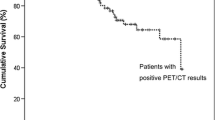Abstract.
This study was designed to assess the value of whole-body positron emission tomography (PET) using 2-[fluorine-18]-fluoro-2-deoxy-D-glucose (FDG) for the diagnosis of recurrent ovarian cancer. Twenty-five patients who had previously undergone surgery for ovarian cancer were imaged using whole-body FDG-PET. During the 4 weeks preceding the PET study, conventional imaging, comprising computed tomography (CT) and magnetic resonance (MR) imaging of the abdomen and/or pelvis, was performed and serum CA125 levels were measured. PET imaging was commenced at 60 min after the intravenous administration of FDG in all patients. PET results were compared with the results of conventional imaging and CA125 levels, and related to pathological findings and clinical follow-up for more than 6 months. FDG-PET showed a sensitivity of 80% (16/20), a specificity of 100% (5/5) and an accuracy of 84% accuracy (21/25) for the diagnosis of recurrent ovarian cancer. The sensitivity, specificity and accuracy of conventional imaging were 55% (11/20), 100% (5/5) and 64% (16/25), respectively. PET could detect recurrent lesions in seven of nine patients in whom conventional imaging was falsely normal, while conventional imaging was true positive in two of four patients with false-negative PET results. The CA125 results showed a sensitivity of 75% (15/20), a specificity of 100% (5/5) and an accuracy of 80% accuracy (20/25). Among the 15 patients with true-positive CA125 results, PET correctly detected abnormal foci of recurrence in 13 patients (86.7%) whereas conventional imaging showed recurrent lesions in only eight patients (53.3%). In conclusion, our preliminary study demonstrates that FDG-PET may be accurate and useful for the detection of tumour recurrence when conventional imaging is inconclusive or negative, especially in patients with abnormal CA125 levels.
Similar content being viewed by others
Author information
Authors and Affiliations
Corresponding author
Additional information
Received 1 October and in revised form 8 December 2001
Electronic Publication
Rights and permissions
About this article
Cite this article
Torizuka, T., Nobezawa, S., Kanno, T. et al. Ovarian cancer recurrence: role of whole-body positron emission tomography using 2-[fluorine-18]-fluoro-2-deoxy-D-glucose. Eur J Nucl Med 29, 797–803 (2002). https://doi.org/10.1007/s00259-001-0750-9
Published:
Issue Date:
DOI: https://doi.org/10.1007/s00259-001-0750-9




